Compiled and edited by Veronica M. Berounsky, Ph.D. ’90
Share Your News With Aboard GSO
1960s | 1970s | 1980s | 1990s | 2000s | 2010s | 2020s | In Memoriam
1960s
Don Gordon, M.S. ’64, has become a Canadian oceanographic historian and limnologist. He led the development of the book Voyage of Discovery; Fifty Years of Marine Research at Canada’s Bedford Institute of Oceanography (BIO), which celebrated the institution’s 50th anniversary. Don has also prepared histories of the development of oceanography at Dalhousie University and the Marine Ecology Laboratory at BIO. While at GSO, he enjoyed Saul Saila’s limnology course and, 60 years later, is applying what he learned to conduct water quality studies of lakes around Halifax, Nova Scotia in support of municipal and provincial land and water management activities.
1970s
On December 21, Secretary of the Navy Carlos Del Toro announced that a future oceanographic survey ship will be named USNS Robert Ballard (T-AGS 67) in honor of Robert Ballard, Ph.D. ’74, a retired U.S. Navy commander, former director of the Center for Ocean Exploration, and GSO professor. The name selection follows the tradition of naming survey ships after explorers, oceanographers and marine surveyors.
Doug Vaughan, Ph.D. ’77, wrote “I and my wife Nancy Donovan Vaughan, M.S. ’77, worked for Oak Ridge National Laboratory from 1977 through 1982 when we moved to Beaufort, S.C. and I went to work for the National Marine Fisheries Service. I retired in August 2011. Since 2015, I have been involved with the Friends of the Beaufort Library and the local American Music Festival. Nancy is involved with weaving for the Beaufort Historical Association and Tai Chi. We also enjoy river cruises and Road Scholar trips.” They are looking forward to visiting Rhode Island and seeing Peter Doering, M.S ’76, Ph.D. ’81 who was best man at their wedding.
Andrew J Sweatt, M.S. ’78, has retired and is working at Wake Forest University School of Medicine, and still lives in North Carolina
1980s
Patricia (Clem) Ritacco, M.S. ’80, is a U.S. administrator for Streams of Living Water. Pat is an essential link between their ministry in Africa and their global partners. She also handles the communications and grant applications for North America and Australia.
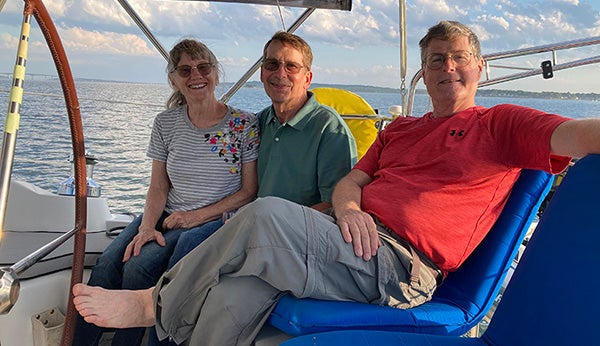 When Jeff Frithsen, Ph.D. ’84, and his wife Elise Striz, sailed the east coast last summer, they relaxed with Mary Worobec, Ph.D. ’82, and Peter Doering, M.S ’76, Ph.D. ’81, on Septentrio in Wickford Harbor.
When Jeff Frithsen, Ph.D. ’84, and his wife Elise Striz, sailed the east coast last summer, they relaxed with Mary Worobec, Ph.D. ’82, and Peter Doering, M.S ’76, Ph.D. ’81, on Septentrio in Wickford Harbor.
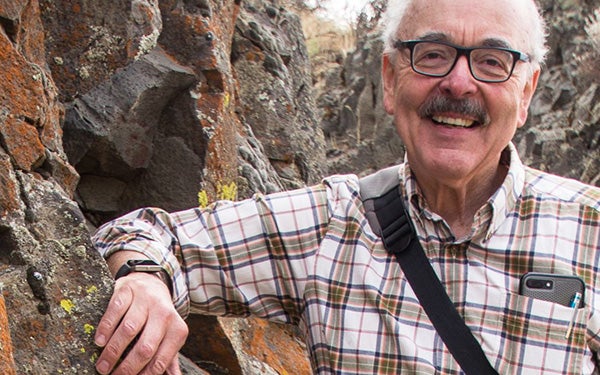 David Muerdter, Ph.D. ’82, says, “I find great satisfaction in learning about the geology of the areas I live in and then sharing what I find.” Dave and his wife of 42 years, Nancy Penrose (they met when she was hired in 1977 to manage Jim Kennett’s GSO lab) moved to New Orleans in 1982 where Dave worked for Amoco, then on to Seattle in 1988 to work for a geophysical software firm. Dave volunteers at the Oregon Coast Aquarium, the Oregon State University Hatfield Marine Science Visitor Center and the USFS Cape Perpetua Visitor Center. In December, he gave a talk as part of the Cape Perpetua Collaborative Speaker Series: “Yachats Geology with David Muerdter: Is the Yachats Basalt Related to Yellowstone?”
David Muerdter, Ph.D. ’82, says, “I find great satisfaction in learning about the geology of the areas I live in and then sharing what I find.” Dave and his wife of 42 years, Nancy Penrose (they met when she was hired in 1977 to manage Jim Kennett’s GSO lab) moved to New Orleans in 1982 where Dave worked for Amoco, then on to Seattle in 1988 to work for a geophysical software firm. Dave volunteers at the Oregon Coast Aquarium, the Oregon State University Hatfield Marine Science Visitor Center and the USFS Cape Perpetua Visitor Center. In December, he gave a talk as part of the Cape Perpetua Collaborative Speaker Series: “Yachats Geology with David Muerdter: Is the Yachats Basalt Related to Yellowstone?”
R/V Endeavor was off Florida this winter where she was carrying out research for chief scientist Bill Johns, Ph.D. ’84, a professor in the Department of Ocean Sciences at the Rosenstiel School of Marine, Atmospheric, and Earth Science
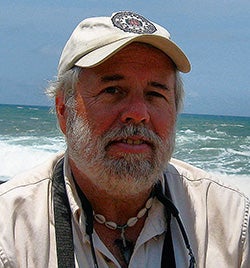 The expertise of GSO professor Robert Kenney, Ph.D. ’84, a member of the Atlantic Large Whale Take Reduction Team that advises the federal government on how to reduce entanglements, is in high demand because of the debate over connections between lobster trap lines and entanglement of the endangered North Atlantic right whale. What we need to do, says Bob, is “take rope out of the water.”
The expertise of GSO professor Robert Kenney, Ph.D. ’84, a member of the Atlantic Large Whale Take Reduction Team that advises the federal government on how to reduce entanglements, is in high demand because of the debate over connections between lobster trap lines and entanglement of the endangered North Atlantic right whale. What we need to do, says Bob, is “take rope out of the water.”
For more than 30 years the freighter Oleander, with an acoustic Doppler profiler installed in its hull, has been profiling upper ocean currents on weekly trips between Bermuda and New Jersey. 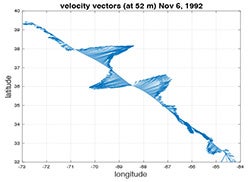 An article published by GSO professors Tom Rossby and Kathleen Donohue, Ph.D. ’96, and Sandra Fontana, M.S. ’86, and Magdalena Andres, M.S. ’02, Ph.D. ’09, about the first 25 years of the project noted that the Gulf Stream exhibits significant year-to-year variations but no evident long-term trend in transport.
An article published by GSO professors Tom Rossby and Kathleen Donohue, Ph.D. ’96, and Sandra Fontana, M.S. ’86, and Magdalena Andres, M.S. ’02, Ph.D. ’09, about the first 25 years of the project noted that the Gulf Stream exhibits significant year-to-year variations but no evident long-term trend in transport.
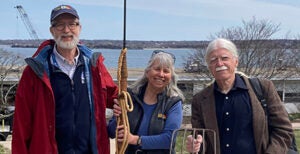 A GSO tradition since 1979, “The Harpoon Seminar” continued on Friday, March 31. The emcees were, from left, Walter Berry, Ph.D. ’87, Veronica M. Berounsky, Ph.D. ’90 and Jim Bisagni, M.S. ’76, Ph.D. ’91, who brought UMass–Dartmouth SMAST colleagues and their Bullrakes to GSO.
A GSO tradition since 1979, “The Harpoon Seminar” continued on Friday, March 31. The emcees were, from left, Walter Berry, Ph.D. ’87, Veronica M. Berounsky, Ph.D. ’90 and Jim Bisagni, M.S. ’76, Ph.D. ’91, who brought UMass–Dartmouth SMAST colleagues and their Bullrakes to GSO.
Amy Bower, Ph.D. ’88, is featured in the Tumble Science Podcast for Kids called “The Science of Ocean Sounds.” Amy is legally blind and uses sound to study ocean currents. Through her underwater sound scavenger hunt, she uses sounds to introduce blind people and people with limited vision to oceanography.
On February 10, GSO produced the second Speed Networking event. Thank you to the eight graduates who volunteered to talk about their jobs with GSO and ocean engineering students: Emily Burns, Ph.D. ’07, Andy Greene, Ph.D. ’10, Matt Horn, Ph.D. ’11, Kim Hyde, Ph.D. ’06, Jim Latimer, Ph.D. ’89, Jason McNamee, Ph.D. ’18, Bob Rheault, Ph.D. ’94 and Sally Sutherland-Pietrzak, OE M.S. ’87.
1990s
A study of the Northeast U.S. by the nonprofit First Street Foundation was featured in a front-page article in The Providence Journal. The foundation’s chief data officer, Ed Kearns, Ph.D. ’96, noted, “The likelihood that storms are coming your way in the future is increasing.”
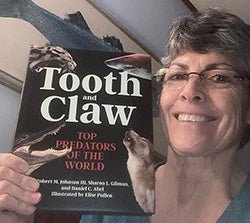 Sharon Larimer Gilman, Ph.D. ’92, writes “Craig Gilman, M.S. ’88, Ph.D. ’92, and I are retiring (or “graduating” as we prefer to think of it) from Coastal Carolina University in South Carolina this spring. Our plan is to do whatever we want, whenever we want to! And having received an advance copy of the book in the photo, time for some shameless self-promotion! As of May 9, a book I am co-author on, Tooth and Claw: Top Predators of the World, will be available from Princeton University Press and Amazon. Rob Young, Ph.D. ’92, assisted with the marine mammals chapter.”
Sharon Larimer Gilman, Ph.D. ’92, writes “Craig Gilman, M.S. ’88, Ph.D. ’92, and I are retiring (or “graduating” as we prefer to think of it) from Coastal Carolina University in South Carolina this spring. Our plan is to do whatever we want, whenever we want to! And having received an advance copy of the book in the photo, time for some shameless self-promotion! As of May 9, a book I am co-author on, Tooth and Claw: Top Predators of the World, will be available from Princeton University Press and Amazon. Rob Young, Ph.D. ’92, assisted with the marine mammals chapter.”
Meghan Cronin, Ph.D. ’93, of NOAA’s Pacific Marine Environmental Laboratory in Seattle, Wash., was elected a 2023 Fellow of the American Meteorological Society. She is also an affiliate professor at the University of Washington’s School of Oceanography and is involved in numerous international climate and ocean projects, panels and committees.
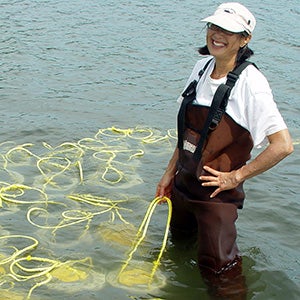 Microplastics are bits of plastic up to 5 millimeters in size. Kay Ho, Ph.D. ’91, a research scientist for the Environmental Protection Agency working on sediment research in Narragansett Bay, finds microplastics everywhere. She estimates that 70% of all microplastics that enter waterways end up in the sediments.
Microplastics are bits of plastic up to 5 millimeters in size. Kay Ho, Ph.D. ’91, a research scientist for the Environmental Protection Agency working on sediment research in Narragansett Bay, finds microplastics everywhere. She estimates that 70% of all microplastics that enter waterways end up in the sediments.
Christian Lacasse, Ph.D.’97, is a senior geologist at the Geological Survey of Brazil (SGB-CPRM).
Stephanie Dutkiewicz, Ph.D. ’98, decided to spend a few dollars on a raffle ticket and won a kayak. She was happy to support the Narrow River Preservation Association and is very excited to be able to paddle on Narrow River, also known as Pettaquamscutt Estuary.
On January 18, Whitley Saumweber, Ph.D. ’05, director of the Stephenson Ocean Security Project, opened the Center for Strategic and International Studies’ Ocean Security Forum 2023. Saumweber also moderated a panel discussion titled “The Maritime SAFE Act and its Implications for U.S. Foreign Policy” featuring Kelly Kryc, Ph. D. ’98, deputy assistant secretary for international fisheries, at NOAA.
Catalina Martinez, ’97, M.S. ’00, M.M.A. ’02, M.B.A.’14, who was based at GSO as the regional program manager for NOAA Ocean Exploration, is now Ocean Exploration’s equity advisor. She spoke at GSO on “Navigating a Sea of Options, Opportunities, and Obstacles: My Circuitous Journey to a Career in Ocean Science.” justice work she has participated in with the URI community and beyond for the past 25 years.
2000s
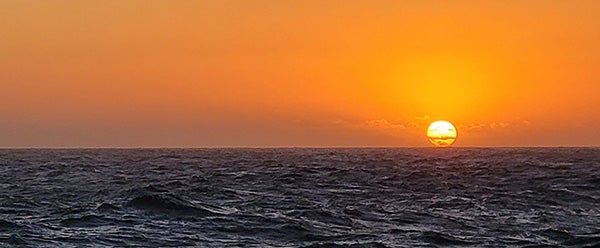 Roger “Pat” Kelly, M.S.’01 sent this sunset photo from the ship Bold Horizon. He was working on NASA’s Sub-Mesoscale Ocean Dynamics Experiment (S-MODE) cruise for GSO professor Melissa Omand. Offshore of San Francisco, Calif., they collected water samples for calibrating on-board and remote-asset optical instrumentation operating within the study area. These observations will be used to evaluate high-resolution, high-altitude ocean color measurements made by NASA’s new PRISM sensor array.
Roger “Pat” Kelly, M.S.’01 sent this sunset photo from the ship Bold Horizon. He was working on NASA’s Sub-Mesoscale Ocean Dynamics Experiment (S-MODE) cruise for GSO professor Melissa Omand. Offshore of San Francisco, Calif., they collected water samples for calibrating on-board and remote-asset optical instrumentation operating within the study area. These observations will be used to evaluate high-resolution, high-altitude ocean color measurements made by NASA’s new PRISM sensor array.
There was a strong GSO presence at the fall meeting of the New England Estuarine Research Society (NEERS) in Providence, RI. The welcome was given by GSO Dean Paula Bontempi, Ph.D. ‘01. Past President Susan Adamowicz, Ph.D. ’02, and President Courtney Schmidt, M.S. ‘09, Ph.D. ’14, presented the Ketchum Award for best graduate student presentation to GSO students Matthew Dunn and Michael Potter (Honorable Mention).
URI Clinical Professor Sunshine Menezes, Ph.D. ’05 was elected a fellow by the American Association for the Advancement of Science.
On December 9, Linda Auker, M.S. ’06, assistant professor of biology and environmental studies program director at Misericordia University, organized her institution’s first-ever Ocean Sustainability Symposium. As she noted, “Even though we live inland here in northeastern Pennsylvania the ocean impacts us directly—the food we eat, the medicine we take, and even our toothpaste, are brought to us by the sea. Living by the Susquehanna River, we are part of the Chesapeake Bay estuary, and we can trace our impacts directly into the ocean.”
University of Delaware Professor Tobias Kukulka, Ph.D. ’06 notes that “microplastics are ubiquitous in Delaware Bay with concentrations that typically exceed those in the open ocean.” On December 9, he gave a talk at GSO on “Transport of marine debris (and other buoyant material): From upper ocean turbulence to Delaware Bay.”
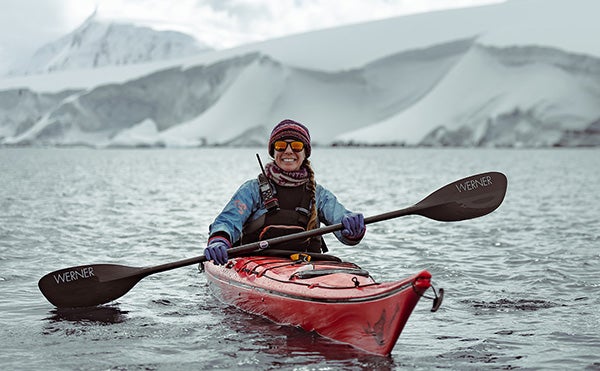 Kelly Henry, M.S. ’07, knows how very fortunate she was to continue her work as a sea kayak guide in a beautiful new area—the Antarctic. She is back home in Wales now, doing more guiding and teaching in her local waters.
Kelly Henry, M.S. ’07, knows how very fortunate she was to continue her work as a sea kayak guide in a beautiful new area—the Antarctic. She is back home in Wales now, doing more guiding and teaching in her local waters.
Congratulations to Brooke Longval, Ph.D. ’09, who completed the 300-mile Everglades Challenge on March 10 in six days, nine hours and six minutes. It is an unsupported adventure race for kayaks, canoes and small sailboats that runs from St Petersburg to Key Largo, through Everglades National Park. Competitors must carry all necessary camping and safety gear, food and water for the duration of the race, as well as a personal locator beacon and tracking device. 64 of the nearly 90 entrants finished within the allotted eight days. Brooke paddled a 19’ Kevlar Mirage sea kayak with a 0.8 square-meter sail to a class win as the only solo female paddler in this year’s event.
2010s
The third talk of the spring GSO Public Lecture Series was given by a panel on “Women in Ocean Science,” which included Katy Croff-Bell, Ph.D. ’11.
Jason Krumholtz, Ph.D. ’12, started a new position as Stewardship Coordinator at the newly designated Connecticut National Estuarine Research Reserve that encompasses Long Island Sound.
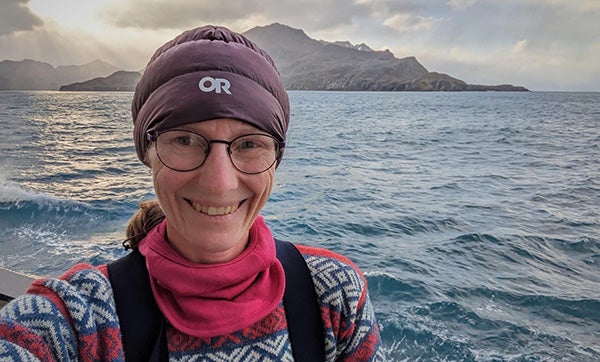 Alison Cleary, M.S. ’10, Ph.D. ’14, is the Marie Sklodowska-Curie Actions Global Fellow with the Brit ish Antarctic Survey. She recently finished the Southern Ocean, Antarctic and Falklands leg on the RRS Discovery for the project called: “Parasites in Antarctic Krill: diversity, distribution and impact.”
Alison Cleary, M.S. ’10, Ph.D. ’14, is the Marie Sklodowska-Curie Actions Global Fellow with the Brit ish Antarctic Survey. She recently finished the Southern Ocean, Antarctic and Falklands leg on the RRS Discovery for the project called: “Parasites in Antarctic Krill: diversity, distribution and impact.”
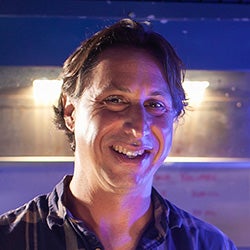 An assistant professor in URI’s Ocean Engineering department Brennan Phillips, Ph.D. ’16, uses 3D printers to make casings for tiny, inexpensive, underwater cameras that remain waterproof even at the enormous pressures found at deep sea work. This technology can fashion a variety of parts using 3D printers ranging from deep sea fiber optic cable casings to, during the pandemic, medical ventilator parts.
An assistant professor in URI’s Ocean Engineering department Brennan Phillips, Ph.D. ’16, uses 3D printers to make casings for tiny, inexpensive, underwater cameras that remain waterproof even at the enormous pressures found at deep sea work. This technology can fashion a variety of parts using 3D printers ranging from deep sea fiber optic cable casings to, during the pandemic, medical ventilator parts.
In a recent ecoRI article with a companion PBS Weekly video, Conor McManus, M.S. ’12, Ph.D. ’17, chief of the R.I. Department of Environmental Management’s Division of Marine Fisheries, talked about rising temperatures in Narragansett Bay and said scup is the most prominent example of Mid-Atlantic fish moving north in greater numbers because of climate change.
Colleen Peters, M.O. ’19, started a new position as product manager for Kongsberg Maritime Sensors & Robotics in West Warwick, R.I. She was also on a panel, Women in Hydrography, at USHydro2023 in Mobile, Ala.
2020s
Shannon McCarthy, M.O. ’20, is a senior aquarist at Mystic Aquarium in Mystic, Conn.
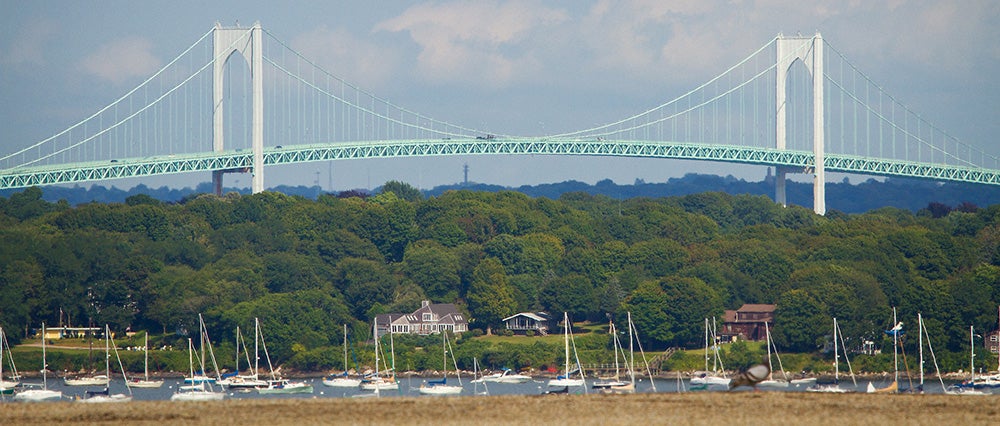
In Memoriam
Wilton “Tony” Sturges III
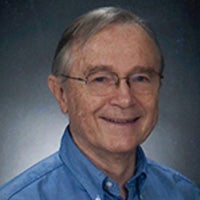 A former GSO Professor, Tony died on December 26, 2022 in Florida. He arrived at GSO in 1966 as an assistant professor and was promoted to associate professor with tenure in 1970. He left in 1972 to join the faculty at Florida State University and remained there until he retired in 2001. Tony was an expert on the Gulf of Mexico, ocean circulation and sea level, and co-edited a monograph on the Gulf of Mexico circulation in 2005. He published over 60 scientific articles, continuing to write through the two decades after his retirement. For more details, see his obituary in the Tallahassee Democrat.
A former GSO Professor, Tony died on December 26, 2022 in Florida. He arrived at GSO in 1966 as an assistant professor and was promoted to associate professor with tenure in 1970. He left in 1972 to join the faculty at Florida State University and remained there until he retired in 2001. Tony was an expert on the Gulf of Mexico, ocean circulation and sea level, and co-edited a monograph on the Gulf of Mexico circulation in 2005. He published over 60 scientific articles, continuing to write through the two decades after his retirement. For more details, see his obituary in the Tallahassee Democrat.
Eva L. Jernigan Hoffman, Ph.D. ’76
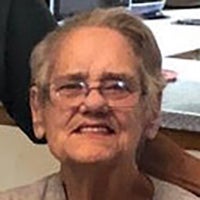 Eva’s scientific career started with a master’s degree earned with Bob Duce at the University of Hawaii. In 1970 Eva followed Bob to GSO along with Jerry Hoffman, who she would later marry. She earned her Ph.D. with Bob and continued working at GSO as a marine research scientist until 1987, first with Bob and later with Jim Quinn. Eva published on a wide range of topics such as atmospheric chemistry, metal pollution, petroleum hydrocarbons and waste oil disposal practices, and was on the first R/V Endeavor cruise to investigate the Argo Merchant oil spill in 1976. She and her husband moved to Denver and worked at U.S. E.P.A. and U.S.G.S., respectively. As project manager at EPA, Eva handled clean-up operations at several mining-related Superfund sites in the mountain states. She retired from federal service in 2004. Eva then revisited her interest in trains by writing and publishing 14 guidebooks, a series called “Flashing Yellow Guidebooks”, that cover most of the western long-distance Amtrak routes and are a rich resource for learning railroad history. Eva left the copyrights for her books to the Midwest Rail Rangers, a nonprofit, rail-history organization in Wisconsin.
Eva’s scientific career started with a master’s degree earned with Bob Duce at the University of Hawaii. In 1970 Eva followed Bob to GSO along with Jerry Hoffman, who she would later marry. She earned her Ph.D. with Bob and continued working at GSO as a marine research scientist until 1987, first with Bob and later with Jim Quinn. Eva published on a wide range of topics such as atmospheric chemistry, metal pollution, petroleum hydrocarbons and waste oil disposal practices, and was on the first R/V Endeavor cruise to investigate the Argo Merchant oil spill in 1976. She and her husband moved to Denver and worked at U.S. E.P.A. and U.S.G.S., respectively. As project manager at EPA, Eva handled clean-up operations at several mining-related Superfund sites in the mountain states. She retired from federal service in 2004. Eva then revisited her interest in trains by writing and publishing 14 guidebooks, a series called “Flashing Yellow Guidebooks”, that cover most of the western long-distance Amtrak routes and are a rich resource for learning railroad history. Eva left the copyrights for her books to the Midwest Rail Rangers, a nonprofit, rail-history organization in Wisconsin.
